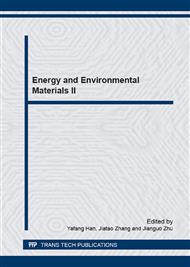[1]
Yang J, Xu C, Wang R. Life cycle assessment methodology of product and application[M]. Beijing, Meteorological Press, (2002).
Google Scholar
[2]
Zuo T, Feng Z, Material recycling in a recycling society and environmental impact assessment[M]. Beijing, Science Press, (2008).
Google Scholar
[3]
Finnveden G, Östlund P. Exergies of natural resources in life-cycle assessment and other applications. Exergies of natural resources in life-cycle assessment and other applications. 1997; 22:923-31.
DOI: 10.1016/s0360-5442(97)00022-4
Google Scholar
[4]
Dewulf J, Bösch ME, Meester BD, Vorst GVD, Langenhove HV, Hellweg S, et al. Cumulative Exergy Extraction from the Natural Environment (CEENE): a comprehensive Life Cycle Impact Assessment method for resource accounting. Environ Sci Technol. 2007; 41:8477-83.
DOI: 10.1021/es0711415
Google Scholar
[5]
Rosen MA. Can exergy help us understand and address environmental concerns? Exergy, An International Journal. 2002; 2:214-7.
DOI: 10.1016/s1164-0235(02)00085-7
Google Scholar
[6]
Rosen MA, Dincer I, Kanoglu M. Role of exergy in increasing efficiency and sustainability and reducing environmental impact. Energ Policy. 2008; 36:128-37.
DOI: 10.1016/j.enpol.2007.09.006
Google Scholar
[7]
Rosen MA. Assessing energy technologies and environmental impacts with the principles of thermodynamics. Appl Energ. 2002; 72:427-41.
Google Scholar
[8]
Szargut J. Analysis of cumulative exergy consumption. Int J Energ Res. 1987; 11:541-7.
Google Scholar
[9]
Dewulf J, Van Langenhove H, Muys B, Bruers S, Bakshi BR, Grubb GF, et al. Exergy: Its Potential and Limitations in Environmental Science and Technology. Environ Sci Technol. 2008; 42:2221-32.
DOI: 10.1021/es071719a
Google Scholar
[10]
Dewulf J, Van Langenhove H. Assessment of the sustainability of technology by means of a thermodynamically based life cycle analysis. Environ Sci Pollut R. 2002; 9:267-73.
DOI: 10.1007/bf02987502
Google Scholar
[11]
Jørgensen SE, Ladegaard N, Debeljak M, Marques JC. Calculations of exergy for organisms. Ecol Model. 2005; 185:165-75.
DOI: 10.1016/j.ecolmodel.2004.11.020
Google Scholar
[12]
Jorgensen SE, Odum HT, Brown MT. Emergy and exergy stored in genetic information. Ecol Model. 2004; 178:11-6.
DOI: 10.1016/j.ecolmodel.2003.12.036
Google Scholar
[13]
Jørgensen SE, Nors Nielsen S. Application of exergy as thermodynamic indicator in ecology. Energy. 2007; 32:673-85.
Google Scholar
[14]
Mandal S, Ray S, Roy S, Jørgensen SE. Investigation of thermodynamic properties in an ecological model developing from ordered to chaotic states. Ecol Model. 2007; 204:40-6.
DOI: 10.1016/j.ecolmodel.2006.12.014
Google Scholar
[15]
Zhang J, Jørgensen SE, Tan CO, Beklioglu M. A structurally dynamic modelling-Lake Mogan, Turkey as a case study. Ecol Model. 2003; 164:103-20.
DOI: 10.1016/s0304-3800(03)00051-6
Google Scholar
[16]
Bendoricchio G, Jørgensen SE. Exergy as goal function of ecosystems dynamic. Ecol Model. 1997; 102:5-15.
DOI: 10.1016/s0304-3800(97)00091-4
Google Scholar
[17]
Niu Z, Wang C. Carbon cycle Sensing Technology and Application[M]. Beijing, Science Press, (2008).
Google Scholar
[18]
Luo Y, Wang X, Zhang Z. Biomass and its allocation of forest ecosystems in China[M]. Beijing, Chinese Forestry Press, (2013).
Google Scholar
[19]
Li H, Lei Y. Estimation and evaluation of forest biomass carbon storage in China[M]. Beijing, Chinese Forestry Press, (2010).
Google Scholar
[20]
Fang J, Liu G, Xu S. Biomass and net production of forest vegetation in China[J]. Acta Ecologica Sinica. 1996(05): 497-508.
Google Scholar
[21]
Chen S, Wang S, Zhou Y. Estimation of Chinese grassland productivity using remote sensing[J]. Transactions of the CSAE. 2008(01): 208-212.
Google Scholar
[22]
Ni J. Carbon storage in terrestrial ecosystems of China: estimates at different spatial resolutions and their responses to climate change. Climatic Change. 2001; 49:339-58.
Google Scholar
[23]
Fang J, Chen A, Peng C, Zhao S, Ci L. Changes in forest biomass carbon storage in China between 1949 and 1998. Science. 2001; 292:2320-2.
DOI: 10.1126/science.1058629
Google Scholar
[24]
Wang SQ, Zhou CH, Luo CW. Studying carbon storage spatial distribution of terrestrial natural vegetation in China. Progress in Geography. 1999; 18:238-44.
Google Scholar
[25]
Zheng W, Bao W, Gu B, He X, Leng L. The carbon content of terrestrial higher plants and their characteristics. Chinese Journal of Ecology. (2007).
Google Scholar
[26]
Deng X, Jiang Q, Yin F, Ke X, Qu R. Changes in China's arable land productivity and the Interregional Protection Strategy. Rural Finance Research. 20115-10.
Google Scholar
[27]
http: /cnmlca. bjut. edu. cn.
Google Scholar


